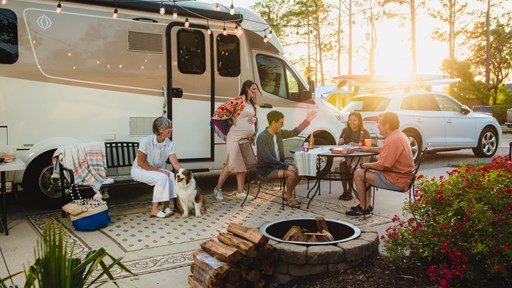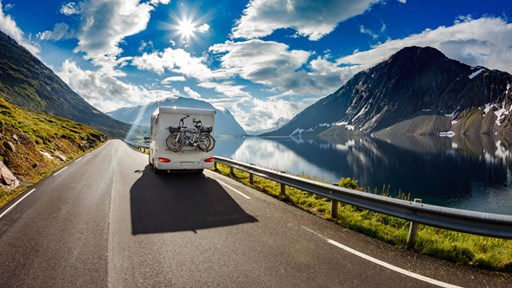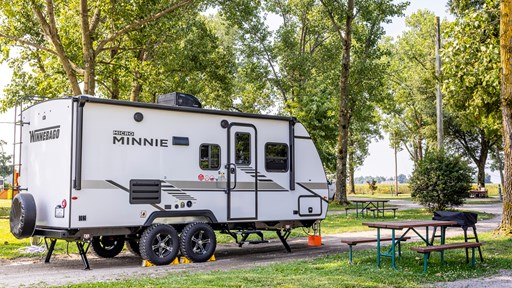RVing With Infants and Toddlers: Tips for a Safe and Successful Camping Trip
Many parents can’t wait to pass their love for camping and the outdoors onto their child, but did you know that infancy and the toddler years are actually the best time to do it? Research shows that much of a child’s important brain development happens within the first few years. One of the best ways to establish a sense of learning and curiosity in your baby is to expose them to different types of stimulating experiences. Camping is full of exciting sights, sounds, textures and smells that your child will love exploring.
Early childhood is the ideal time to start taking camping vacations because you don’t have to worry about school schedules or find a sitter when relaxing in the outdoors for a few days. A camping trip can help teach your child how to adapt to new environments and situations, which is a skill they will continue to develop into childhood. For parents, camping with your infant or toddler means you have an excuse to wake up early each morning and catch the sunrise. Compared to older children, babies are much more flexible when it comes to the activities you participate in.
Infant and Toddler-Friendly RVing
Camping with your infant or toddler allows you to start creating lasting memories right from the start. Even if your child is too young to remember the details of the outing, regular camping trips will begin to foster a sense of adventure and interest in the world around them. RVs allow you to enjoy all of these camping-related benefits but from the comfort of a controlled, familiar environment.
Keep reading to learn some helpful tips and tricks for successful RV travel with toddlers.
Infant and Toddler-Friendly RVs
Today, RVs have more features and layouts than ever before. As you search for the best RV for your family, always check for:
- Space: The best RV for toddlers is one with plenty of space for them to move and play. Separate rooms or divided sleeping areas are also very useful for helping your child fall asleep.
- Functionality: When buying a new or used RV for your family, a functional heating and cooling system is one of the most important things to check for. Consider how the RV is constructed — is it durable? You want an investment that will last your family many camping trips to come. Also consider things like available lighting, outlet placement and whether there is a built-in bathtub for your baby.
- Storage: Interior storage is essential for stocking your RV with diapers and baby toys, but you should also consider a rig that has a toy hauler. A toy hauler is a type of exterior storage meant to store recreational items like bikes or kayaks, but it is also an ideal place to store a baby stroller, bouncer, playpen or other gear.
- Safety: Finally, safety is the most important feature of any RV. Make sure seatbelts are available and functional, and look for optional features like a carbon monoxide detector, rearview camera or electronic braking system. If you already own a rig without these safety features, contact a professional and ask about upgrade options, as well as information about installing seat belts in an RV.
Some families have found success with RVs like the Keystone Avalanche, Fleetwood Flair, Holiday Rambler Vacationer and Keystone Laredo because of spacious layouts with bunk areas, ample storage and built-in bathrooms. Choose your RV carefully — it will be your new home away from home!

Essential RV Gear for Infants
In addition to standard camping essentials, be sure to bring along everything you need for your infant or toddler’s daily routine and a few extra supplies to make the trip easier. Here is some RV gear for infants you may want to consider:
- Car seat: If you are camping in a towable RV, you don’t have to consider car seats inside the motorhome, as you will be traveling with your child in your separate vehicle. Otherwise, most booster or car seats require front-facing seats, so keep this in mind while RV shopping. When choosing a motorhome child car seat, remember to abide by all laws and weight recommendations.
- Crib: Some RVs are big enough to accommodate a full-size crib, while others call for a travel-sized or RV baby crib. You also want to take the crib’s weight into account, as some RVs have weight limits.
- Changing bag: Look for a portable bag that rolls out into a changing station. This will be helpful when you have to change your baby in the RV, public restroom or when out sightseeing.
- Toys: Bring some of your child’s favorite indoor toys so you can keep your baby entertained on rainy days and during downtime. For outdoor toys, consider weather-safe toddler favorites like a wagon, starter bicycle or a baby-friendly camping set.
- First-aid kit: A baby-friendly first-aid kit includes any medicines your baby needs, as well as cotton balls, baby thermometer, medicine dropper, nasal aspirator, bandages, saline drops and antibiotic cream.
- Protection: To keep your toddler safe from the sun and bugs, use baby-safe sunscreen and insect repellant. For day trips and time spent outdoors, consider a sunhat and shaded campsite to help keep your child cool.
- Recreation: If your toddler is old enough to participate in recreational activities, bring along everything they need to stay safe, such as a life jacket or swimming floaties. Look for toddler-friendly camping chairs, so even when you’re relaxing at the campsite, your child can feel like they are a part of the group.
- Baby carriers: You may want to participate in some activities that are not stroller-friendly, such as hiking or boating. Bring along a baby carrier that you can attach to your body.
- Bathtub: If your RV does not have a built-in bathtub, don’t forget to bring a portable one — as well as gentle washcloths — for clean up.
- High chair: If you use a high chair to feed your baby, look for a foldable or portable model that you can easily wipe clean.
9 Tips for RVing With Infants and Toddlers
Once you have found the perfect RV and packed your suitcases full of baby-friendly camping gear, it is time for your camping trip! Here are nine tips to help you have a successful RV trip with your baby.
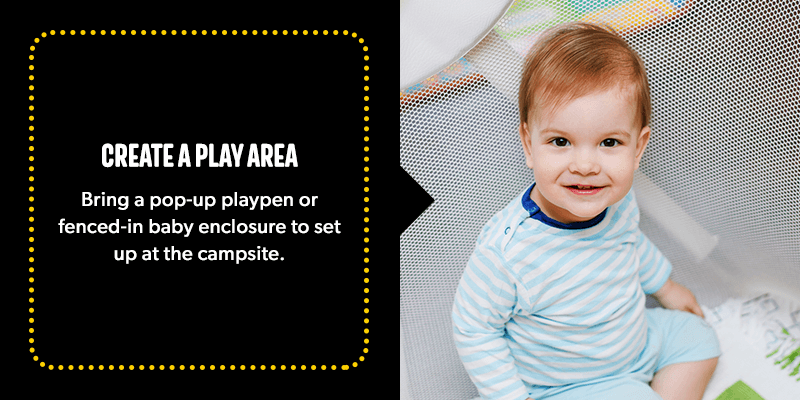
1. Create a Play Area
Many parents find it useful to bring a pop-up playpen or fenced-in baby enclosure to set up at the campsite. This way, you can put your toddler inside with their favorite toys and watch them play from the comfort of your camping chair. When creating a play area at your campsite, make sure it is on level ground, far away from any rocks, tree roots or the fire ring. If you want to keep your little one off the ground, bring along a foam mat or soft, interlocking tiles to create a mess-free play area.
2. Babyproof Everything
If you are a parent, you already know the importance of babyproofing everything. Here are some tips for babyproofing your RV:
- Cover the outlets and stovetop knobs.
- Add corner guards to counters and tables.
- Add a child lock or baby gate to all doors leading outside.
- Install a door alarm, so you know anytime someone comes in or goes out.
- Keep cabinets and cupboard doors secured shut, as many of them lead to electrical components or other dangerous areas of the RV.
- Keep all hazardous gear — like fishing hooks, matches, roasting forks and lighter fluid — locked away and out of reach.
While outside, be aware of potential dangers, such as poisonous plants, biting insects, wildlife and the fire pit.
3. Start Small
Work your way up to extended RV camping trips by starting with short trips not too far from home. This way, you can see how your baby responds to the changes and whether there are any additional considerations you need to account for. If a weekend away still seems like a big step, that’s okay! Set your RV up at home and have a trial run. Once you have mastered the trial run and the weekend trip, gradually increase the amount of time and distance traveled for each camping trip.
4. Stick to Your Baby’s Schedule
The best way to transition into infant and toddler RVing is to stick to your child’s established schedule. This includes when they wake up and go to bed, mealtime and playtime. Since you are on a camping trip, find unique ways to incorporate this routine into your camping traditions. If your child is an early riser, encourage the whole family to wake up and catch the sunrise and enjoy an early campfire breakfast. You could also make nap time the part of your trip where you focus on relaxation. If your baby is young enough to sleep in their car seat or in a baby carrier, pack a picnic and enjoy some time by the water or at a nearby park until they wake up. By sticking to a familiar schedule, everyone will be more comfortable and know what to expect. There will also be minimal readjustments to make once you return home.
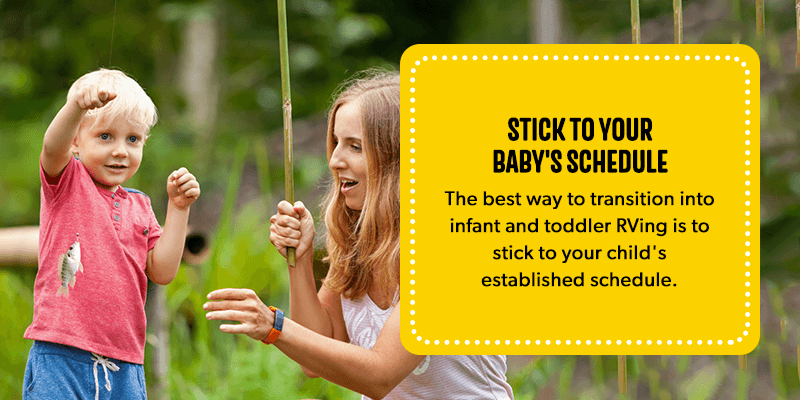
5. Rest Before Traveling
Although camping trips are a good time to kick back and unwind, exploring the outdoors and caring for a baby at the same time can be a little tiring. It is also possible that the change in scenery or sleeping conditions might make it difficult for you and your baby to feel fully rested on your trip. To combat this, make sure you get plenty of quality sleep before your camping vacation. By starting your journey refreshed, you are setting yourself up for success.
6. Establish a Sleep Area
One of the biggest challenges when RVing with kids — especially young ones — is bedtime. One simple way to help a toddler sleeping in an RV to stay asleep is to designate a baby-only sleep area. Make this area as comfortable and familiar as possible, including their usual bedding.
Consider the following:
- Light-blocking curtains: Hang black-out curtains in your child’s sleep area so they will not be disturbed by the sunlight or any lights from street lamps, headlights or campfires. Light-blocking curtains will also help regulate the temperature inside your RV, creating a comfortable sleeping environment.
- White noise: Campgrounds are full of vacationers and pets, which means they are not always the quietest place for infants trying to sleep. Drown out the noise with a white sound machine or fan. If your baby is used to some background noise, turn the TV or radio on a low volume.
- Stability: Many RVs will shake if other people close the door or move around too much. To let your baby sleep without disturbance, make sure you set your RV up the correct way and use things like stabilizer jacks. If you still feel movement, bring along a baby monitor and try to stay outside during naptime.
7. Bring Fresh Water
If you choose to camp somewhere primitive or without access to electricity or clean water, don’t forget to bring some with you. You can find gallon jugs of water at the grocery store, and they are great for ensuring safe bathing, drinking and bottle-washing water. If your baby is drinking formula, ask your pediatrician for specific guidance.
Remember not to let your child drink from or expose them to river, pond, stream or lake water if you are hiking or traveling away from the campground. Though beautiful to look at, these sources often contain contaminants such as parasites, bacteria and viruses.
8. Expect to Go Through More Clothes Than Normal
Regardless of the destination, always expect to go through more clothes than you normally do at home. This is a general rule of camping that applies to both babies and adults. Because your baby will be exposed to dirt and is more likely to sweat, bring plenty of backup outfits. If your RV does not accommodate a washer and dryer, stay at a campground with on-site laundry facilities so you can keep your suitcases light and prevent staining.
9. Choose the Right Campground
Look for a campground that is safe, clean and near family-friendly attractions. Choose a destination that has a good balance of grown-up fun and activities that a toddler will enjoy. For example, many places have aquariums and zoos that your little one will love, as well as easy walking trails and sightseeing opportunities.
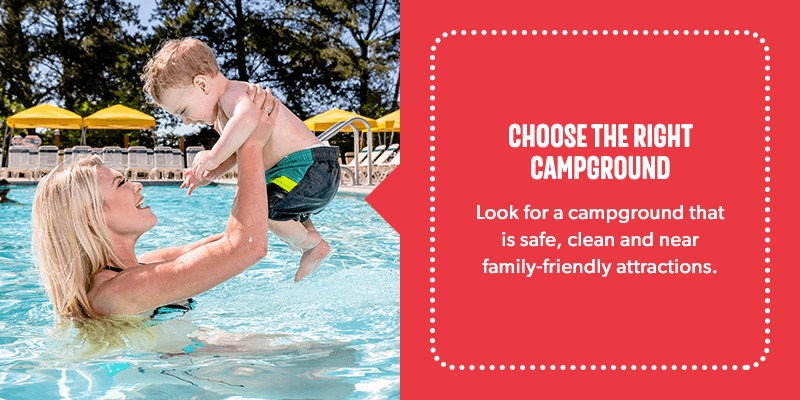
Enjoy a Family Camping Trip at Kampgrounds of America
With these tips in mind, RVing with your infant or toddler is sure to be an exciting and memorable adventure for all of you. KOA has more than 500 locations across North America, and each one has everything you need for a fun camping trip — including on-site amenities that allow you to have a good time while remaining a short walk away from your RV. Every KOA RV Site is level and spacious enough for the whole family. Choose from either Back-In or Pull-Thru Sites, as well as full 30 or 50-amp electrical hook-ups. Many KOA locations also have RV Sites with KOA Patio™, a spacious on-site patio area that provides additional seating and extra amenities.
Visit KOA online to learn more about RV Sites and reserve a stay for your family today!




















